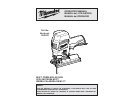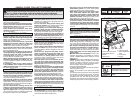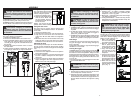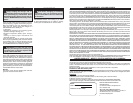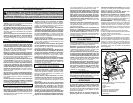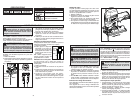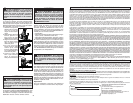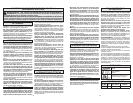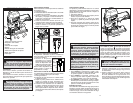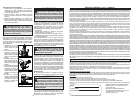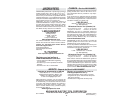
4
5
Support
roller
Lug
Fig. 1
Slot
Blade
Fig. 2
Using the anti-splinter device
The anti-splinter device helps
stabilize the workpiece and
reduce workpiece splinter.
1. Remove the battery pack.
2. Slide the anti-splinter device
onto the shoe. Make sure
the anti-splinter device is
installed fl ush with the bot-
tom of the shoe.
NOTE: Do not use the anti-
splinter device when making bevel/angle cuts.
Using the shoe cover
The shoe cover is used to prevent marring and
scratching of the workpiece surface. To attach the
shoe cover:
1. Remove the battery pack.
2. Hook the front of the cover over the steel shoe.
3. Snap the rear of the shoe cover over the back
of the shoe. Be sure both sides are snapped in
place.
4. When the shoe cover is not needed, remove it by
pulling the tabs on rear of the shoe cover down.
Unhook the front of the shoe cover and remove.
Adjusting the shoe
The shoe may be tilted up to 45° in either direction.
Do not use the anti-splinter device when making
bevel/angle cuts. To set a tilt angle for bevel/angle
cuts:
1. Remove the battery pack.
2. Loosen the shoe adjustment lever and pull the
base forward slightly.
3. To set the angle to 0°, push the shoe backward
into the 0° detent and tighten the shoe adjust-
ment lever.
4. To set any other angle, tilt the tool to the desired
angle and tighten the shoe adjustment lever.
Make a test cut to verify the angle.
Starting and stopping the tool
1. To start the tool, grasp the handle fi rmly and pull
the trigger. An LED is turned on when the trigger
is pulled.
2. To vary the speed, increase or decrease pres-
sure on the trigger. The further the trigger is
pulled, the greater the speed.
3. To stop the tool, release the trigger. Allow the tool
to come to a complete stop before removing the
blade from a partial cut or laying the tool down.
Fuel Gauge
To determine the amount of charge left in the bat-
tery, pull the trigger. The Fuel Gauge will light up
for 2-3 seconds.
To signal the end of charge, 1 light on the fuel gauge
will fl ash for 2-3 seconds.
Locking the trigger
To lock the trigger, push the trigger lock from the
lock side of the tool. The trigger will not work while
the switch is in the locked position. Always lock the
trigger and remove the battery pack before perform-
ing maintenance and changing accessories. Lock
the trigger when storing the tool and when the tool
is not in use.
To unlock the trigger, push the trigger lock from the
unlock side of the tool.
OPERATION
WARNING Always remove battery
pack before changing or removing
accessories. Only use accessories specifi -
cally recommended for this tool. Others may
be hazardous.
WARNING To reduce the risk of injury,
wear safety goggles or glasses with
side shields. Keep hands away from the blade
and other moving parts.
WARNING To reduce the risk of explo-
sion, electric shock and property damage,
always check the work area for hidden gas
pipes, electrical wires or water pipes when
making blind or plunge cuts.
Plunge Cutting
Plunge cuts can be made into soft materials without
a pre-drilled hole. Harder materials require a starter
hole with a diameter slightly over the width of the
blade. To make a plunge cut:
1. Make sure nothing be-
low the intended cut
area will be damaged.
2. Without turning the
tool on, place the front
edge of the shoe solidly
on workpiece (Fig. 5).
3. Align the blade with
the intended cut line,
but keep it above the
workpiece.
4. Using the front edge of
the shoe as a pivot, turn
on the tool and gradu-
ally lower the blade into
the workpiece (Fig. 6).
5. When the shoe is fl at
against the workpiece,
normal cutting may take
place (Fig. 7).
WARNING To reduce the risk of injury,
do not start the tool with the blade contacting
the workpiece.
Special Cutting Techniques
1. Straight cuts — To obtain a perfectly straight
cut, clamp a strip of wood as a guide along the
workpiece or use a rip guide.
2. Bevel cuts — adjust the shoe to the correct angle
(see Adjusting the Shoe).
3. Cutting Sheet Metal — sheet metal may vibrate
when being cut. To minimize vibration clamp, the
workpiece to a wood base.
Making the Cut
1. Position the tool with the front part of the shoe
on the workpiece and start the tool.
2. Hold the shoe fi rmly against the workpiece and
guide the tool along the desired cutting line. Do
not feed into the work too hard, light pressure on
the saw blade will achieve the optimum cutting
speed.
ASSEMBLY
WARNING Recharge only with the
charger specified for the battery.
For specifi c charging instructions, read the
operator’s manual supplied with your charger
and battery.
Inserting/Removing the Battery
To remove the battery, push in the release buttons
and pull the battery pack away from the tool.
To insert the battery, slide the pack into the body of
the tool. Make sure it latches securely into place.
WARNING Always remove battery
pack before changing or removing
accessories. Only use accessories specifi -
cally recommended for this tool. Others may
be hazardous.
Installing saw blades
Use only T-Shank jig saw blades.
1. Remove the battery pack.
2. Pull out and hold the Quik-Lok tension lever.
3. Fit the saw blade into the groove in the support
roller and push it fi rmly into the plunger as far
as it will go; the lug of the saw blade must be in
the plunger.
4. Release the Quik-Lok tension lever to secure
the saw blade.
5. Check that the saw blade is held fi rmly; the slot
in the plunger will be at an angle to the blade.
Fig. 3
Anti-splinter
device
Shoe
Fig. 4
Fig. 5
Fig. 6
Fig. 7
Plunger



